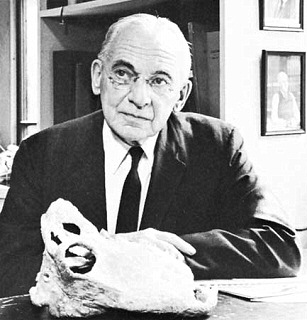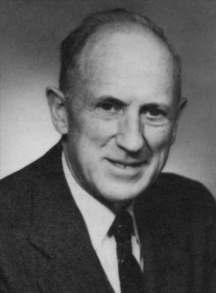
Paleontology, also spelled palaeontology or palæontology, is the scientific study of life that existed prior to the start of the Holocene epoch. It includes the study of fossils to classify organisms and study their interactions with each other and their environments. Paleontological observations have been documented as far back as the 5th century BC. The science became established in the 18th century as a result of Georges Cuvier's work on comparative anatomy, and developed rapidly in the 19th century. The term has been used since 1822 formed from Greek παλαιός, ὄν, and λόγος.

Invertebrate paleontology is sometimes described as invertebrate paleozoology or invertebrate paleobiology. Whether it is considered to be a subfield of paleontology, paleozoology, or paleobiology, this discipline is the scientific study of prehistoric invertebrates by analyzing invertebrate fossils in the geologic record.

Alfred Sherwood Romer was an American paleontologist and biologist and a specialist in vertebrate evolution.
Joseph John Sepkoski Jr. was a University of Chicago paleontologist. Sepkoski studied the fossil record and the diversity of life on Earth. Sepkoski and David Raup produced a new understanding of extinction events, by developing a statistical approach to the study of taxonomic diversification. He suggested that the extinction of dinosaurs 66 mya was part of a cycle of mass extinctions that may have occurred every 26 million years. But his most important contribution was the identification of the "Big 5" mass extinctions, events that have shaped the evolution of life on earth.
Oskar Kuhn was a German palaeontologist.

Samuel Wendell Williston was an American educator, entomologist, and paleontologist who was the first to propose that birds developed flight cursorially, rather than arboreally. He was a specialist on the flies, Diptera.

Paleobiology is an interdisciplinary field that combines the methods and findings found in both the earth sciences and the life sciences. Paleobiology is not to be confused with geobiology, which focuses more on the interactions between the biosphere and the physical Earth.

Allopleuron is a genus of extinct sea turtle, which measured 2-to-2.5-metre long in life. The type species is Allopleuron hofmanni. It is a basal member of the clade Pancheloniidae, closely related to Protosphargis. Similar to Protosphargis, it was characterized by shell reduction.
Raymond Cecil Moore was an American geologist and paleontologist. He is known for his work on Paleozoic crinoids, bryozoans, and corals. Moore was a member of US Geological Survey from 1913 until 1949. In 1919 he became professor at the University of Kansas (Lawrence). In 1953 Professor Moore organized the launch and became the first editor of the still ongoing multi-volume work Treatise on Invertebrate Paleontology. Contributors to the Treatise have included the world's specialists in the field. He served as president of the Geological Society of America in 1958. In 1970 he was awarded the Mary Clark Thompson Medal from the National Academy of Sciences.

The history of paleontology traces the history of the effort to understand the history of life on Earth by studying the fossil record left behind by living organisms. Since it is concerned with understanding living organisms of the past, paleontology can be considered to be a field of biology, but its historical development has been closely tied to geology and the effort to understand the history of Earth itself.

The Hungarian Natural History Museum in Budapest, dating back to 1802, houses the largest natural history collections of Hungary and the region.
Macrocephalochelys is an extinct genus of turtles in the family Chelydridae. It was first described from a partial skull from the Pliocene found in Ukraine by Piboplichko and Taraschchuk in 1960. It was assigned to the family Chelydridae by R. L. Carroll in 1988 although it had been hypothesised to belong in Chelydridae by Chkhikvadze in 1971.

The Fox Hills Formation is a Cretaceous geologic formation in the northwestern Great Plains of North America. It is present from Alberta on the north to Colorado in the south.
John West Wells was an American paleontologist, biologist and geologist who focused his research on corals.

Paleontology in Illinois refers to paleontological research occurring within or conducted by people from the U.S. state of Illinois. Scientists have found that Illinois was covered by a sea during the Paleozoic Era. Over time this sea was inhabited by animals including brachiopods, clams, corals, crinoids, sea snails, sponges, and trilobites.

Paleontology in Missouri refers to paleontological research occurring within or conducted by people from the U.S. state of Missouri. The geologic column of Missouri spans all of geologic history from the Precambrian to present with the exception of the Permian, Triassic, and Jurassic. Brachiopods are probably the most common fossils in Missouri.
Alfred R. Loeblich Jr was an American micropaleontologist. He was married to Helen Niña Tappan Loeblich and the two co-authored a number of important works on the Foraminifera and related organisms.

Stuart Weller was an American paleontologist and geologist.
Maurice Goldsmith Mehl was an American paleontologist and professor in the Department of Geology at the University of Missouri.

Ralph Works Chaney was an American paleobotanist. Chaney was the first paleobotanist to develop in detail the use of morphological characters of fossil leaves to deduce ecological information of the given era. He was also the first to use quantitative study of fossil floras in an attempt to arrive at a precise estimate of species dominance in vegetation, understanding that species in a given ecosystem evolve cooperatively.
This page is based on this
Wikipedia article Text is available under the
CC BY-SA 4.0 license; additional terms may apply.
Images, videos and audio are available under their respective licenses.














